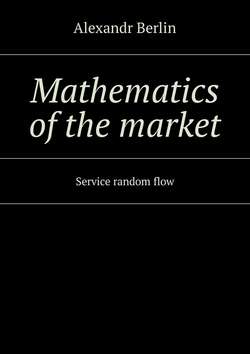Читать книгу Mathematics of the market. Service random flow - Alexandr Berlin - Страница 8
Chapter 1. What are the REELECTION CONSUMPTION. unit of measure of supply and demand
1.4.1. The intensity of the supplies of goods
ОглавлениеBy analogy with the concepts of instantaneous and average intensities of random flow may to considered instantaneous and the average intensity of the supply of goods. However, in the theory and practice of calculation of the capacity of the market it is advisable to use the average intensity of the flows offers supply of goods. The intensity the incoming supply of goods means the offer of goods per unit of time. As a unit of measurement of the intensity of the supply of goods adopted the value a=1, i.e. the maximum volume of the supply of goods the (Preal= Pmax).
The following theorem facilitates the determination of intensity of the supply goods
It shows that this value has the property of ergodicity, which is that
Average at the time is equal to the average of the ensemble.
In this case, monitoring the arrival of shipments on time can be replaced by monitoring the number of simultaneously incoming groups of consumers.
The theorem on the quantification of the intensity incoming supply of goods:
The intensity of incoming supply of goods, which is expressed in units o relative consumption, quantitatively equal to the average number of simultaneously busy consumer groups serving this load.
Suppose that during the T hours continuously recorded the number of simultaneously busy groups of consumers market, which receives steady flow of supplies for consumer groups. Let the result of the observations was that during the time t1 was busy υ1 consumer groups, during the time t2. was busy v2 consumer groups, etc. (Fig.1.1). In General can imagine that during the time ti was busy υi consumer groups,
Σni=1 ti= T
and where n is the number, the value of v which is taken, within T hours.
Total time, when busy all consumers of the market at time ti expressed by the product of υit. In the time interval T total time when all users busy of the market will be expressed by amount. This amount, it is supplies of goods all consumers of the market at the time T.
The supplies of goods what, all consumers acquired of the market per unit time are equal to:
Aserv = (1/T) Σni=1vi ⋅ ti
On the other hand, the average number of simultaneously consumer groups occupied during the time T can be defined as a weighted average of ti:
v‘= (v1t1 + v2t2 +•••+ vntn) / (t1 + t2 + ⋯ tn) =
= (1/T) Σ ni=1 (vi ⋅ti)
therefore Aserv= v’
A theorem about the quantitative assessment of the intensity of the incoming floe supplies of goods.
To quantify the intensity of the incoming flow supply of goods you can use the following theorem:
The intensity of the incoming flow supplies of goods, which expressed in terms of relative consumption, creates a simplest flow of goods, which quantitatively equal to the mathematical expectation of the number of goods (c’), received for a time equal to the average duration of one consumption of one batch products (t’cons)
Figure 1.1. The moments of arrives of goods
Let the inputs of the market comes a simple flow of goods with the intensity μ. We assume that the duration of consumption – T is a finite random variable
0≤T≤ Tmax is independent of the stream type of the incoming supplies goods with the average value t, Consider the time interval [t1, t2) such that t2 – t1> T max. The mathematical expectation of the number of supplies placed on the market in the time interval [t1, t2) denoted by Λ (t1, t2) =μ (t1.t2).
Part of these supplies is consumed to the moment t2 (Fig. 1.1 a), and the other part does not end in this time (Fig. 1.1 b). Denote the mathematical expectation of the number of goods received in the time interval [t1, t2) and what not purchased to the time t2, denote ρ. In addition to products that arriving to market in the time interval [t1, t2), it is necessary to take into account products that have arrived up to time t1 and the time t2 are not yet purchased. We denote the expected number of goods that began before the time t1 and are ended in the time interval [t1, t2), denote ε (Fig. 1.1), and the expected number of calls that started before t1 and ended after the time t2, denote ζ (Fig. 1.1 g). Since t2 – t1> Tmax, then ζ=0. For the simplest flow ρ=ε.
By definition, the mathematical expectation of entering the market supply of goods during a time interval [t1, t2),
a (t1,t2) = [μ (t2—t1) – ρ +ε] ⋅t ̅=μ⋅ t’consum (t2—t1)
and the intensity of the inbound supplies:
a= [a (t1,t2)] / (t2—t1) = μ⋅ t’cosum
The mathematical product (multiplication) is the mathematical expectation of the number of goods received over the average duration of consumption. The theorem is proved.
For example, suppose that one day (between t1=0 and t2=24 hours) enters N⋅c=100⋅4=400 items of goods.
Let the average duration of a consumption equal per day. Therefore, for time will receive 400⋅ 1/40 =10 items of goods.
At the same time, the number of the mathematical expectation of the number of proposals received per day is equal to:
A= N⋅ c’(T) /T=400⋅ (1/40) =10 items of goods per day
